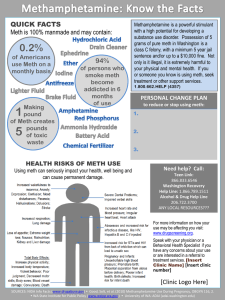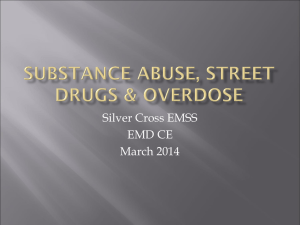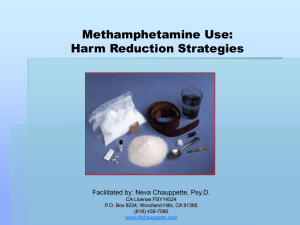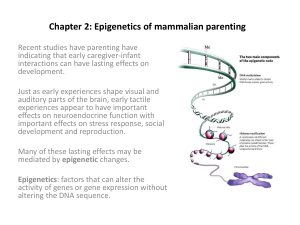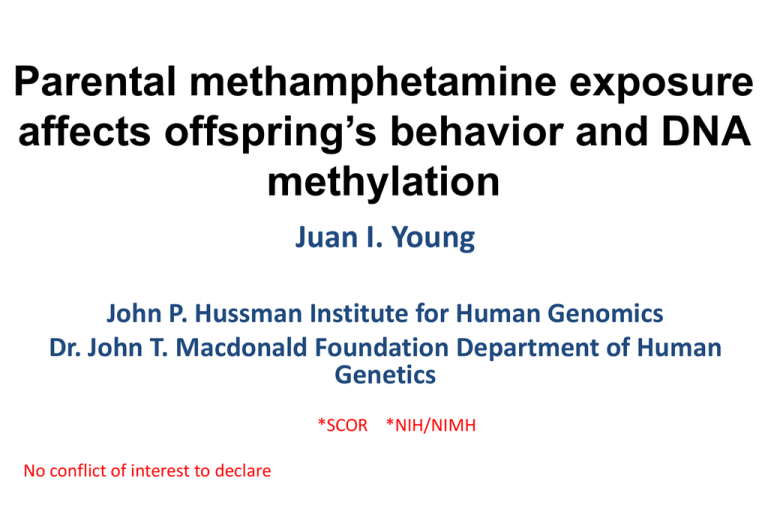
Parental methamphetamine exposure
affects offspring’s behavior and DNA
methylation
Juan I. Young
John P. Hussman Institute for Human Genomics
Dr. John T. Macdonald Foundation Department of Human
Genetics
*SCOR *NIH/NIMH
No conflict of interest to declare
Heritable transmission of environmentally induced
phenotypes: multigenerational inheritance
• Studies suggest the transmission of behavioral traits
acquired by one generation to subsequent generations
through epigenetic processes
Exposure to a drug of
abuse
Phenotype A
Phenotype B
(methamphetamine)
Multigenerational
persistence
Phenotype B
Environmetal intervention: Exposure to
metamphetamine
• Methamphetamine is a major drug of abuse in many
parts of the world. Current use of METH surpasses the
use of cocaine and opiates.
• Methamphetamine addiction is associated with
psychotic behavior and long term cognitive impairment.
• Surveys of past-month illicit drug use among females
aged 15-44 showed that 6-7% of these women were
pregnant, and continued to use drugs during all three
trimesters of pregnancy; 2,000-3,000 abused
Methamphetamine.
Environmetal intervention: Exposure to
metamphetamine
• A major concern is the prospect that parental
methamphetamine abuse and in utero exposure may
have debilitating effects on generations that are either
indirectly exposed, or even unexposed to the drug.
• Exposure: simulated the human pattern of parental
METH exposure.
– Male and female mice (F0) were exposed to an
intermittent escalating regiment of METH or saline
from adolescence through adulthood and during
pregnancy.
F1 phenotype:
motivational effects
of cocaine
•Long lasting effect of
methamphetamine on CPP
(sexually dismorphic)
•Male pups insensitive to
maternal influence
•Female pups sensitive to
maternal effects
Molecular Psychiatry , (18 February 2014)
In utero:
Fostering dam:
S S
S M
S S
S M
M M
S M
M M
S M
F1 phenotype:
associative learning and
memory
•Long lasting effect of
methamphetamine on fear
conditioining
•Sensitive to maternal
effects : Fostering of METH In utero:
Fostering dam:
pups by saline dams
restored dampened
freezing of METH pups
S S
S M
S S
S M
M M
S M
M M
S M
Molecular Psychiatry , (18 February 2014)
F1 phenotype:
activity and anxiety
In utero:
Fostering dam:
•Long lasting effect of
methamphetamine-induced
maternal effect
•Maternal care of METH
dams had a significant sexIn utero:
dependent effect on
Fostering dam:
anxiety-like behavior of
saline offspring
S
S
S S
S M
M
M
S
M
S S
S M
M M
S M
M
S
M M
S M
Molecular Psychiatry , (18 February 2014)
F1 summary (Behavior)
• Prenatal METH exposure produces long-lasting
changes in the offspring’s behavioral phenotypes.
• Effects are phenotype dependent:
CPP: Sexual dimorphism
Maternal influence on the phenotype (independent of dam
treatment) also sexually dimorphic
Fear conditioning: Maternal influence on the phenotype
dependent on dam treatment (“saline rescue”)
Open field: Maternally influenced phenotye (dependent on
dam treatment (“METH induced”)
Light/dark box:Maternally influenced phenotye (dependent on
dam treatment (“METH induced”) and sexually dimorphic
Mechanism by which prenatal exposures affect long
term phenotypes
• One possible mechanism involves
alterations of DNA methylation marks in
the genome.
• compared the DNA methylome of the
hippocampus of the F1 SpSd, MpMd,
SpMd and MpSd mice by MeDIPmicroarray
NimbleGen microarray: covers 15,936 UCSC
annotated CpG islands and all RefSeq gene
promoter regions
F1 epigenotype: DNA methylation in hippocampus
• The group that exhibited the highest number of identified
peaks was MpMd, suggesting that the combination of in
utero exposure to METH and METH-induced maternal
care mostly promotes DNA methylation.
• A comparison of MpMd vs. SpSd samples identified
1822 methylation peaks aligning to gene promoter
regions as differentially methylated regions (DMR). The
majority of these DMR showed hypermethylation in
MpMd, as compared to SpSd.
F1 epigenotype: DNA methylation in hippocampus
• Validation: 75% of selected
DMR showed methylation
differences by bisulfite
sequencing concordant with the
array data .
• More variability in methylation
levels in samples from
maternally METH exposed mice
than in SpSd samples,
suggesting that the response of
hippocampal cells to maternal
METH exposure is
heterogeneous.
Molecular Psychiatry , (18 February 2014)
SpSd vs MpSd
DMR: effect of
paternal METH on
pup under the care
of a saline dam
SpMd vs MpMd
DMR: effect of
paternal METH on
pup under the care
of a METH dam
429 847
SpSd vs SpMd
DMR: effect of
METH on maternal
care (on saline
embryos)
1360 317
MpMd vs MpSd
DMR: effect of
METH on maternal
care on METH
embryos
1216 243
489 769
SpSd vs MpMd
DMR: combination
of effect of paternal
METH on embryo
and effect of METH
on maternal care
SpSd vs MpMd
DMR: combination
of effect of paternal
METH on embryo
and effect of METH
on maternal care
1240 552
1240 552
SpMd vs MpMd
MpMd vs MpSd
EMR: No
effect of
METH on
maternal care
EMR: No
effect of
paternal
METH on
pup
DMR:
effect of
METH on
maternal
care
: 111 47
: 129 49
: 62 35
: 70 33
Paternal METH effects on the F1 pup’s methylome
independent of maternal care influences.
DMR:
effect of
paternal
METH on
pup
Paternal METH effects on the F1 pup’s methylome
mediated by altered maternal care.
Numbers in black: hypermethylated DMR; numbers in red: hypomethylated DMR; EMR: equally methylated region.
F1 epigenotype: DNA methylation in hippocampus
Methylation
induced by
METHexposure
(insensitive to
maternal
modulation)
62
Adora1 (M & C)
Ilk (C)
Akap5 (C)
Demethylation
induced by
METHexposure
(insensitive to
maternal
modulation)
35
Camkk2 (M)
Methylation
induced by
METH-altered
maternal care
Demethylation
induced by
METH-altered
maternal care
70
Pcdh8 (C)
Pomc (H)
39
Camk2a (M&C)
Methylation
induced by
interaction of
METHexposure and
METH-altered
maternal care
60
Gsk3b (C)
Demethylation
induced by
interaction of
METHexposure and
METH-altered
maternal care
22
Hdac5 (M&C)
Cln8
Rtn1
Tbx5
Prenatal METH exposure induce changes in several genes
shown to be modulated by: direct exposure to drugs of
abuse, and maternal effects.
METH-induced methylation, which should produce gene
silencing, occurs in promoters that have a histone
modification signature of active transcription.
Top 10 enriched histone terms for the hypermethylated DMR
Name
1 H3K4me3 H1
H3K4me3 H1 Derived Mesenchymal Stem
2
Cells
3 H3K4me3 H9
4 H3K4me3 iPS DF 6.9
5 H3K4me3 CD8 Naive Primary Cells
6 H3K4me3 iPS DF 19.11
7 H3K4me3 CD19 Primary Cells
8 H3K9ac H1
H3K4me3 H1 BMP4 Derived Trophoblast
9
Cultured Cells
10 H3K4me3 IMR90
P-value Z-score
3.93e-22 -2.26
Score
98.08
1.10e-14 -2.60
70.01
1.68e-12
4.61e-12
1.59e-13
3.63e-10
7.63e-10
4.42e-8
-2.84
-2.79
-2.39
-2.81
-2.64
-3.10
64.02
60.87
58.81
49.50
44.87
40.60
7.84e-8 -2.84
35.95
1.77e-6 -2.95
30.24
METH-induced demethylation was observed in promoters
associated with an epigenetic signature of transcriptional
silencing.
Top 10 enriched histone terms for the demethylated DMR.
1
2
3
4
5
6
7
8
9
10
Name
H3K27me3 Fetal Lung
H3K27me3 H1 BMP4 Derived Trophoblast
Cultured Cells
H3K27me3 H1
H3K27me3 Colonic Mucosa
H3K27me3 Stomach Smooth Muscle
H3K27me3 CD4 Memory Primary Cells
H3K27me3 CD4 Naive Primary Cells
H3K27me3 CD3 Primary Cells
H3K27me3 Penis Foreskin Keratinocyte
Primary Cells
H3K27me3 CD8 Memory Primary Cells
P-value Z-score
8.73e-4 -1.52
Score
10.68
3.51e-3 -1.65
9.34
0.01
0.02
0.03
0.04
0.03
0.06
-1.87
-1.69
-1.40
-1.46
-1.29
-1.45
8.59
6.08
4.74
4.60
4.48
4.05
0.04
-1.27
4.00
0.06
-1.39
3.89
F1 summary
• Prenatal METH exposure produces long-lasting
changes in the offspring’s brain epigenome that could
contribute to the initiation and maintenance of the
observed behavioral phenotypes.
• Our experiments indicate a significant influence of
maternal effects on the epigenotype and behavioral
phenotype of the F1 progeny.
• Parental METH exposure has important consequences
on the hippocampal transcriptional landscape of the
progeny; promoters that are usually active become
methylated while inactive promoters are demethylated.
Aknowledgements
Yossef Itzhak
Ian Ergui
Michael kaplan
Vladimir Camarena

